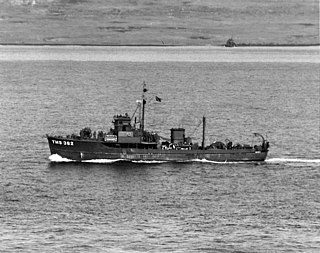
USS Hornbill was a YMS-1-class minesweeper of the YMS-135 subclass built for the United States Navy during World War II. After World War II, she continued to be in use until the mid-1950s.

USS Robin was a YMS-1-class minesweeper of the YMS-135 subclass built for the United States Navy during World War II.

USS Turkey (AMS-56/YMS-444) was a YMS-135 subclass of YMS-1-class minesweepers built for the United States Navy during World War II.

USS Lark was a YMS-1-class minesweeper of the YMS-135 subclass built for the United States Navy during World War II.

USS Brant was a YMS-1-class minesweeper built for the United States Navy during World War II.

USS Pelican was a YMS-1-class minesweeper of the YMS-135 subclass acquired by the U.S. Navy for the task of removing mines that had been placed in the water to prevent ships from passing.

USS Seagull was a YMS-1-class minesweeper of the YMS-135 subclass built for the United States Navy during World War II.

USS Sanderling (AMS-35/AMCU-49/MHC-49/YMS-446/PCS-1393) was the lead ship of her subclass of YMS-1-class minesweepers built for the United States Navy during World War II.

USS Grouse (AMS-15/YMS-321) was a YMS-1-class minesweeper of the YMS-135 subclass built for the United States Navy during World War II.

USS Waxbill (MHC-50/AMCU-50/AMS-39/YMS-479/PCS-1456) was a YMS-1-class minesweeper of the YMS-446 subclass acquired by the U.S. Navy for the task of removing mines placed in the water to prevent ships from passing.

USS Hawk was a YMS-1-class minesweeper of the YMS-135 subclass built for the United States Navy during World War II.
USS Cardinal was a YMS-1-class minesweeper of the YMS-135 subclass built for the United States Navy during World War II. She was the third ship in the U.S. Navy to be named for the cardinal.
USS Linnet (AMS-24/YMS-395) was a YMS-1-class minesweeper of the YMS-135 subclass built for the United States Navy during World War II.

USS Kite was a YMS-1-class minesweeper of the YMS-135 subclass built for the United States Navy during World War II.

USS Mockingbird (AMS-27/YMS-419) was a YMS-1-class minesweeper of the YMS-135 subclass built for the United States Navy during World War II. She was the second U.S. Navy ship to be named Mockingbird.

USS Nightingale was a YMS-1-class minesweeper of the YMS-135 subclass acquired by the U.S. Navy for the dangerous task of removing mines from minefields laid in the water to prevent ships from passing.

USS Reedbird (AMS-51/YMS-291) was a YMS-1-class minesweeper of the YMS-135 subclass acquired by the U.S. Navy for the dangerous task of removal of mines that had been placed in coastal waters to prevent ships from passing.

USS Brambling (AMS-42/YMS-109) was a YMS-1-class auxiliary motor minesweeper acquired by the U.S. Navy for the task of removing mines from water that had been placed there to prevent ships from passing.

USS Barbet (AMS-41/YMS-45) was a YMS-1-class auxiliary motor minesweeper acquired by the U.S. Navy for the task of removing mines that had been placed in the water to prevent ships from passing.

USS Swallow was a YMS-1-class minesweeper of the YMS-446 subclass built for the United States Navy during World War II. She was originally laid down as PCS-1416, and, when renamed later in her career, became the third U.S. Navy ship named for the swallow.












